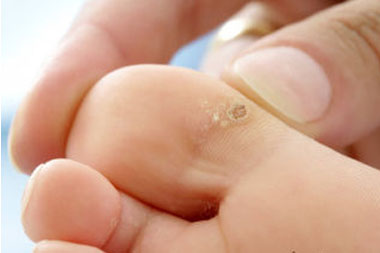TREATMENTS - PLANTAR WARTS
Papilloma, Verruca Plantaris
WHAT'S THE PROBLEM?
A plantar wart is a small skin lesion that resembles a callus and is found on the bottom of the foot or toes. The term "plantar" doesn't mean only farmers get them. "Plantar" means they occur on the bottom surface of the foot. It is usually under 1 cm diameter, but can occur in clusters and be much larger. Sometimes a single larger wart is surrounded by many smaller warts. In this case, they are called mosaic warts.
SINGLE WART / MOSAIC WART
HOW DOES IT FEEL?
A plantar wart feels like a lump under the foot. They are only painful is they are squeezed or pinched from side to side, or if you bear direct weight on them. Warts on other parts of the body, such as the hands, grow elevated above the skin's surface. We bear weight on warts on the bottom of the foot, so they get flattened and pushed into the skin. Most people liken this to walking with a rock attached to the foot, as the thickened callous tissue becomes hard and painful as it gets bigger.
LET'S DO A TEST!
A plantar wart can usually be diagnosed by your doctor based on a characteristic appearance alone. When the doctor trims the hard callus tissue from the surface of the wart, a pattern of small black dots that are actually small blood vessels that feed the wart, is usually seen. The doctor will also test the wart by pressing directly down on it, and then pinching it, squeezing it from side to side. Most warts won't hurt when pressed directly down, but are very painful when pinched. If these findings are present, no further testing is necessary to identify a plantar wart.
HOW DID THIS HAPPEN?
All warts are caused by the Papilloma virus, a slow growing virus which invades the skin. The viruses are common in all of our environments and they don't readily grow on intact skin. But if there is a break in the skin, like a scratch or thorn penetration, this gives the virus the opportunity to get in and start growing. The virus only grows in the epidermis, the thick layer of the skin closest to the surface. It doesn't invade the dermis, the deeper layer of the skin. However, the epidermis and the dermis are closely entwined, and the dermis under the wart grows extra blood vessels and nerves in response to the virus infected cells above it in the epidermis. It is because of these nerves that the wart hurts when pinched and because of these blood vessels that it stays well nourished enough to grow. The virus particles can spread from the main wart, along the cutaneous (skin) nerves, to begin growing remote or satellite warts at a distance from the original site. If enough of this spread occurs, mosaic warts result.
WHAT CAN I DO FOR IT?
Over the counter products that contain the ingredient salicylic acid may be tried if you have good blood flow, good feeling in your feet, and the wart is small. However, their use is slow and frustrating. They are acids which slowing destroy the wart from the surface down. Diabetics or other people with numbness or bad circulation should not use these products, as it can be dangerous for them. You may also try treating the wart by keeping it covered with tape at all times. This seems to prevent the wart from growing as rapidly and may be of some benefit when combined with other treatment. The thick callus tissue can be carefully removed with a pumice stone or file. This must be done in between applications of the salicylic acid medicine.
WHAT WILL MY DOCTOR DO FOR IT?
Your doctor has a number of choices for treating your Plantar Wart. Unfortunately, warts are stubborn entities and even the best methods for removing them allow a high rate of reoccurrence, around 15%.
He/she may choose to use medication that is stronger than what is available at the pharmacy. This can speed up the process. Depending on the size and number of warts, treatment can take from 1-4 months before the wart is completely gone, and like any infection, all parts of it must be completely eliminated, or it will grow back.
Your doctor may choose to use an oral medicine called Tagamet (Cimetadine) or an ointment called Efudex (5-fluorouracil) on the wart.
An additional option is to physically remove the wart at one time, either surgically, with a spoon like instrument called a curette, or with the CO2 laser. The healing time is from 2-4 weeks, depending on the size. Use of the CO2 laser reduces the rate of reoccurrence to 10%, reduces post-operative pain and eliminates any bleeding.
CAN I PREVENT FROM IT HAPPENING AGAIN?
Keep your feet clean and dry. Inspect feet frequently for new warts and begin treating small ones immediately, before they increase in size or number.
|

